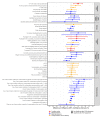Impact of the Ananya program on reproductive, maternal, newborn and child health and nutrition in Bihar, India: early results from a quasi-experimental study
- PMID: 33427822
- PMCID: PMC7757842
- DOI: 10.7189/jogh.10.021002
Impact of the Ananya program on reproductive, maternal, newborn and child health and nutrition in Bihar, India: early results from a quasi-experimental study
Abstract
Background: The Government of Bihar (GoB) in India, the Bill and Melinda Gates Foundation and several non-governmental organisations launched the Ananya program aimed to support the GoB to improve reproductive, maternal, newborn and child health and nutrition (RMNCHN) statewide. Here we summarise changes in indicators attained during the initial two-year pilot phase (2012-2013) of implementation in eight focus districts of approximately 28 million population, aimed to inform subsequent scale-up.
Methods: The quasi-experimental impact evaluation included statewide household surveys at two time points during the pilot phase: January-April 2012 ("baseline") including an initial cohort of beneficiaries and January-April 2014 ("midline") with a new cohort. The two arms were: 1) eight intervention districts, and 2) a comparison arm comprised of the remaining 30 districts in Bihar where Ananya interventions were not implemented. We analysed changes in indicators across the RMNCHN continuum of care from baseline to midline in intervention and comparison districts using a difference-in-difference analysis.
Results: Indicators in the two arms were similar at baseline. Overall, 40% of indicators (20 of 51) changed significantly from baseline to midline in the comparison districts unrelated to Ananya; two-thirds (n = 13) of secular indicator changes were in a direction expected to promote health. Statistically significant impact attributable to the Ananya program was found for 10% (five of 51) of RMNCHN indicators. Positive impacts were most prominent for mother's behaviours in contraceptive utilisation.
Conclusions: The Ananya program had limited impact in improving health-related outcomes during the first two-year period covered by this evaluation. The program's theories of change and action were not powered to observe statistically significant differences in RMNCHN indicators within two years, but rather aimed to help inform program improvements and scale-up. Evaluation of large-scale programs such as Ananya using theory-informed, equity-sensitive (including gender), mixed-methods approaches can help elucidate causality and better explain pathways through which supply- and demand-side interventions contribute to changes in behaviour among the actors involved in the production of population-level health outcomes. Evidence from Bihar indicates that deep structural constraints in health system organisation and delivery of interventions pose substantial limitations on behaviour change among health care providers and beneficiaries.
Study registration: ClinicalTrials.gov number NCT02726230.
Copyright © 2020 by the Journal of Global Health. All rights reserved.
Conflict of interest statement
Competing interests: The authors have completed the ICMJE Unified Competing Interest form (available on request from the corresponding author) and declare no conflict of interest.
Figures

References
-
- World Health Organization. Delivering quality health services: a global imperative for universal health coverage. Geneva: WHO; 2018.
